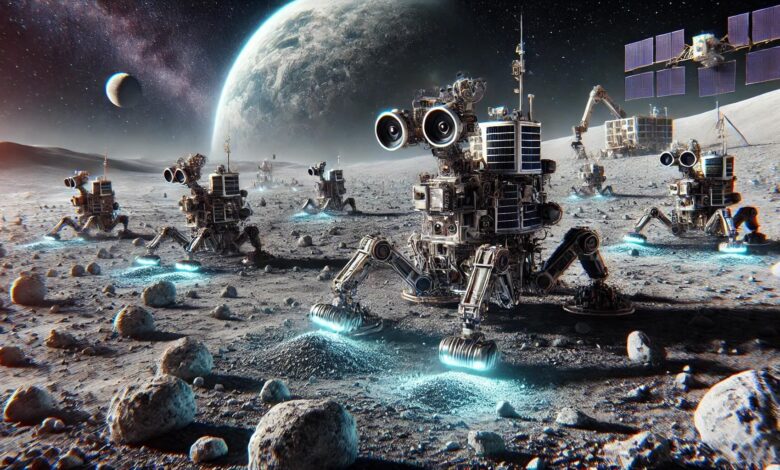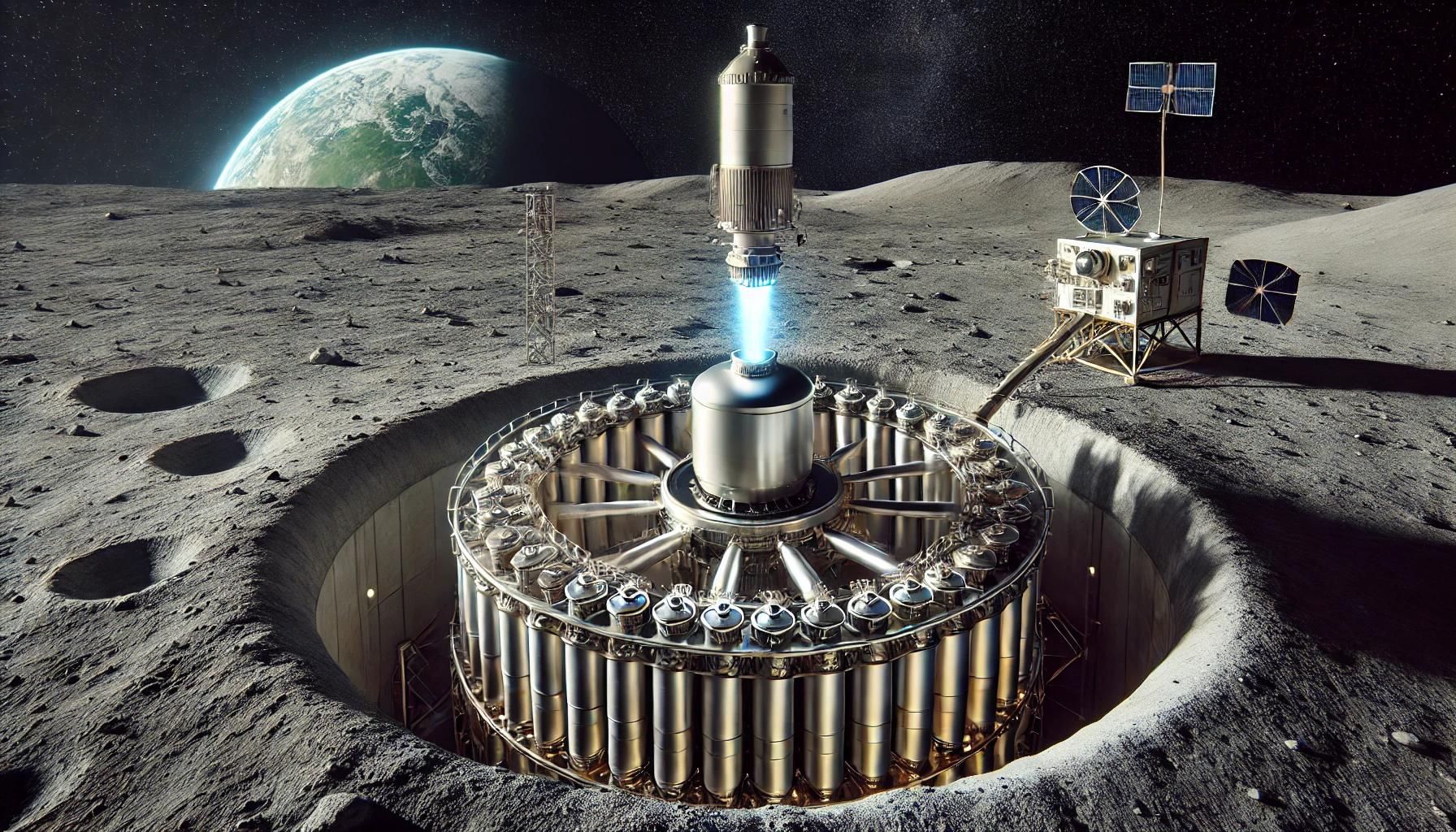The Power of Swarm Robotics

At Tengri, we are pioneering the next frontier in space exploration and resource extraction by leveraging the advanced capabilities of swarm robotics. Drawing inspiration from the coordinated hunting strategies of wolves, which also grace our company logo, we are developing autonomous robotic systems that can adapt, evolve, and thrive in the harshest environments of space. This article explores the fundamentals of swarm robotics, its applications in space mining, and how Tengri is utilizing this groundbreaking technology to discover and extract new mineral resources, ensuring a sustainable future for space exploration.
The Fundamentals of Swarm Robotics
Swarm robotics is a field that focuses on the collective behavior of multiple autonomous robots, known as agents, which work together to accomplish complex tasks. This approach mimics the decentralized and cooperative behaviors observed in nature, such as the coordinated hunting of wolf packs or the foraging patterns of ant colonies.
Key Principles of Swarm Robotics
- Decentralized Control: Unlike traditional robotic systems that rely on a central controller, swarm robotic systems operate on decentralized control. Each robot makes independent decisions based on local information and interactions with neighboring robots. This enhances the system’s robustness and flexibility, as there is no single point of failure.
- Scalability: Swarm robotic systems can easily scale by adding or removing robots without requiring significant changes to the overall system architecture. This scalability is particularly advantageous for large-scale operations such as space mining, where the number of robots can be adjusted based on mission requirements.
- Redundancy: The use of multiple robots ensures redundancy, meaning the failure of one or more robots does not compromise the entire operation. This redundancy is crucial for missions in harsh and unpredictable environments like space, where reliability and resilience are paramount.
- Emergent Behavior: Simple individual behaviors and interactions can lead to complex and adaptive group behavior, known as emergent behavior. This enables swarm robotic systems to perform tasks that would be difficult or impossible for a single robot, such as extensive area coverage, dynamic task allocation, and adaptive problem-solving.
Swarm Robotics in Space Mining
Space mining involves the extraction of valuable resources from celestial bodies, such as asteroids, the Moon, and Mars. Swarm robotics offers numerous advantages for space mining, including enhanced adaptability, efficiency, and resilience. At Tengri, we are harnessing these advantages to revolutionize space mining operations.
Exploration and Mapping
Before mining can commence, it is essential to explore and map the target area to identify resource-rich regions. Swarm robotic systems excel in exploration tasks due to their ability to cover large areas efficiently and adapt to changing conditions.
- Coordinated Exploration: Swarm robots can work together to conduct thorough surveys of the lunar or Martian surface, mapping terrain features and identifying potential resource deposits. Using onboard sensors and communication networks, they can share data and create detailed maps in real-time.
- Adaptive Mapping: The decentralized nature of swarm robotics allows for adaptive mapping strategies. Robots can adjust their exploration patterns based on encountered obstacles, changes in terrain, or new information about resource locations. This adaptability ensures comprehensive coverage and efficient resource identification.
Resource Extraction
Once resource-rich areas are identified, the next step is extraction. Swarm robotics enables efficient and scalable resource extraction processes, ensuring minimal environmental impact and maximum yield.
- Collaborative Mining: Swarm robots can collaborate to perform complex mining tasks, such as drilling, excavation, and material transport. By dividing tasks among multiple robots, the swarm can achieve higher efficiency and productivity compared to traditional single-robot systems.
- In-Situ Resource Utilization (ISRU): Swarm robots can process extracted materials on-site, using local resources to produce the necessary tools and infrastructure for further operations. This reduces the need for resupply missions from Earth and enhances the sustainability of space mining missions.
Autonomous Adaptation and Evolution
A key innovation at Tengri is the integration of evolutionary robotics with swarm robotics. This allows our robotic swarms to adapt and evolve based on the conditions they encounter, ensuring continuous improvement and resilience.
- Evolutionary Algorithms: Evolutionary algorithms enable robots to optimize their behaviors and capabilities over time. By simulating natural selection processes, robots can evolve to perform tasks more efficiently, adapt to new environments, and develop novel solutions to emerging challenges.
- Self-Replicating Systems: Our robotic swarms are designed to use local resources to replicate and repair themselves. This self-replication capability ensures the longevity of mining operations, as damaged robots can be replaced and the swarm can expand as needed.
Transporting Resources to Earth

One of the most significant challenges in space mining is transporting extracted resources back to Earth. At Tengri, we are developing innovative solutions to address this challenge, including the use of spin launching technology.
- Spin Launching: Spin launching involves using a centrifuge-like apparatus to propel payloads into space at high speeds. This method is highly energy-efficient and can significantly reduce the cost of transporting materials from the Moon or other celestial bodies to Earth.
- Orbital Transfer: Once in space, resources can be transferred to Earth-bound spacecraft for transport. Swarm robots can facilitate the transfer process by coordinating the collection and packaging of materials for launch.
The Tengri Advantage: Inspired by Wolves
At Tengri, our inspiration for swarm robotics comes from the coordinated hunting strategies of wolves, which also feature prominently in our company logo. Wolves are known for their teamwork, adaptability, and efficiency in hunting and survival, qualities we seek to emulate in our robotic swarms.
- Teamwork and Coordination: Just as wolves work together to hunt and bring down prey, our robotic swarms coordinate their actions to achieve complex mining tasks. Each robot plays a specific role, and together they form an efficient and effective team.
- Adaptability: Wolves are highly adaptable, capable of thriving in diverse environments. Similarly, our robotic swarms can adapt to the unique conditions of different celestial bodies, ensuring successful mining operations regardless of the challenges they face.
- Efficiency: Wolves optimize their hunting strategies to maximize success with minimal effort. Our robotic swarms use advanced algorithms to optimize their behaviors, ensuring efficient resource extraction and minimal waste.
Future Prospects and Innovations
The future of swarm robotics in space mining is incredibly promising, with several exciting developments on the horizon.
Advanced AI Integration
- Machine Learning: Integrating machine learning algorithms with swarm robotics can enhance the swarm’s ability to learn from past experiences and improve its performance over time. This continuous learning capability ensures that our robotic swarms remain at the cutting edge of technology.
- AI-Driven Decision Making: Advanced AI systems can enable more sophisticated decision-making processes within the swarm. Robots can analyze vast amounts of data in real-time, make informed decisions, and coordinate complex tasks with minimal human intervention.
Expanded Exploration Capabilities
- Multi-Planetary Operations: As we expand our operations beyond the Moon, our robotic swarms will be designed to operate on multiple celestial bodies, including Mars, asteroids, and beyond. Each new environment presents unique challenges and opportunities, and our swarms will be equipped to adapt and thrive.
- Interstellar Exploration: Looking further into the future, swarm robotics could play a crucial role in interstellar exploration. Autonomous robotic swarms can explore distant star systems, identify habitable planets, and pave the way for future human missions.
Sustainable Space Operations
- Environmental Protection: At Tengri, we are committed to sustainable space operations. Our robotic swarms are designed to minimize their environmental impact, ensuring that celestial bodies are preserved for future generations.
- Resource Recycling: By incorporating resource recycling capabilities into our robotic swarms, we can reduce waste and enhance the sustainability of our mining operations. Recycled materials can be used to build new robots, repair existing ones, and produce essential tools and infrastructure.
Swarm robotics represents a revolutionary approach to space mining, offering unparalleled adaptability, efficiency, and resilience. At Tengri, we are harnessing the power of swarm robotics, inspired by the coordinated strategies of wolves, to explore and extract resources from the farthest reaches of the cosmos. Our innovative technologies and commitment to sustainability are paving the way for a new era of space exploration, ensuring that humanity can thrive in the final frontier.
As we continue to push the boundaries of what is possible, Tengri’s robotic swarms will lead the charge, discovering new mineral resources, adapting to new environments, and ensuring a sustainable future for space mining. Join us on this exciting journey as we revolutionize space exploration and unlock the limitless potential of the universe.